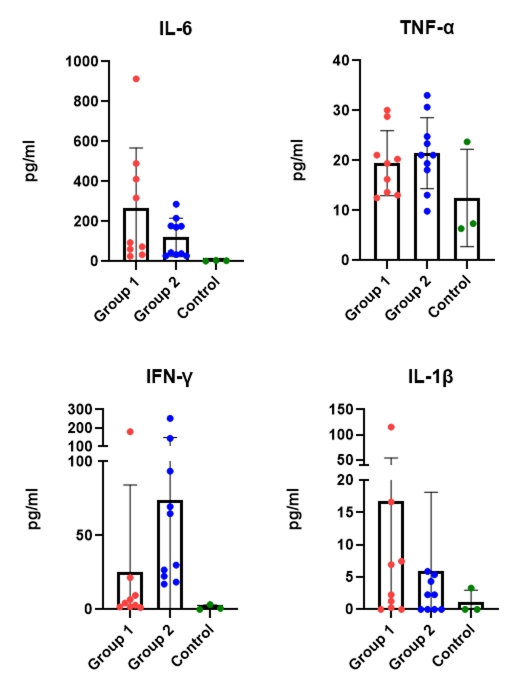Back
Introduction: Murine models of sepsis, such as the cecal ligation and puncture (CLP) model, are typically polymicrobial and associated with a high mortality within hours after the specific intervention. Our aim was to develop a high-throughput, murine model that mimics a slow-paced, monomicrobial sepsis originating from the urinary tract.
Methods: 12-week-old male C57Bl/6 mice (n=23) underwent percutaneous insertion of a 4mm catheter piece into the urinary bladder. The following day Proteus mirabilis (PM) was introduced percutaneously into the bladder in 3 groups: group 1 - 50 µl of a 1x108 CFU/ml solution (n=10), group 2 - 50 µl of a 1x107 CFU/ml solution (n=10), and group 3 (sham mice) - 50 µl of sterile saline (n=3). On day 4 mice were sacrificed. The number of bacteria in urine, adherent to bladder catheters, adherent to/invaded into the bladder tissue as well as a set of 32 pro-/anti-inflammatory cytokines and chemokines were analyzed.
Results: All 23 mice survived the postinterventional period. Mean weight loss was 11% in group 1, 9% in group 2 and 2% in the control group. Mean urine CFU counts were highest in group 1 and all sham mice had negative urine samples. All infected mice had high catheter-adhered bacterial counts. 18/20 infected mice had CFU counts in homogenized splenic tissue indicating septicemia. Cell-free DNA and D-Dimer was highest in group 1 and lowest in the control group. Serum levels of G-CSF were significantly increased in group 1 when compared to controls. Serum levels of IL-6, TNF-a, IFN-? and IL-1ß were all elevated (1.5 to 30-fold) compared to control mice.
Conclusions: We present an easily reproducible, monomicrobial murine model of urosepsis that does not lead to rapid deterioration and death and can therefore be used as a model for prolonged urosepsis. SOURCE OF
Funding: Roman Herout was funded by the Deutsche Forschungsgemeinschaft (DFG, German Research Foundation) - 447437311.

Podium Session
Session: PD19: Infections/Inflammation/Cystic Disease of the Genitourinary Tract: Kidney & Bladder II
PD19-04: A Novel, High-Throughput Urosepsis Mouse Model
Saturday, April 29, 2023
1:30 PM – 1:40 PM CST
Location: S401C
- DL
Dirk Lange, PHD
University of British Columbia
Podium Presenter(s)
Introduction: Murine models of sepsis, such as the cecal ligation and puncture (CLP) model, are typically polymicrobial and associated with a high mortality within hours after the specific intervention. Our aim was to develop a high-throughput, murine model that mimics a slow-paced, monomicrobial sepsis originating from the urinary tract.
Methods: 12-week-old male C57Bl/6 mice (n=23) underwent percutaneous insertion of a 4mm catheter piece into the urinary bladder. The following day Proteus mirabilis (PM) was introduced percutaneously into the bladder in 3 groups: group 1 - 50 µl of a 1x108 CFU/ml solution (n=10), group 2 - 50 µl of a 1x107 CFU/ml solution (n=10), and group 3 (sham mice) - 50 µl of sterile saline (n=3). On day 4 mice were sacrificed. The number of bacteria in urine, adherent to bladder catheters, adherent to/invaded into the bladder tissue as well as a set of 32 pro-/anti-inflammatory cytokines and chemokines were analyzed.
Results: All 23 mice survived the postinterventional period. Mean weight loss was 11% in group 1, 9% in group 2 and 2% in the control group. Mean urine CFU counts were highest in group 1 and all sham mice had negative urine samples. All infected mice had high catheter-adhered bacterial counts. 18/20 infected mice had CFU counts in homogenized splenic tissue indicating septicemia. Cell-free DNA and D-Dimer was highest in group 1 and lowest in the control group. Serum levels of G-CSF were significantly increased in group 1 when compared to controls. Serum levels of IL-6, TNF-a, IFN-? and IL-1ß were all elevated (1.5 to 30-fold) compared to control mice.
Conclusions: We present an easily reproducible, monomicrobial murine model of urosepsis that does not lead to rapid deterioration and death and can therefore be used as a model for prolonged urosepsis. SOURCE OF
Funding: Roman Herout was funded by the Deutsche Forschungsgemeinschaft (DFG, German Research Foundation) - 447437311.

